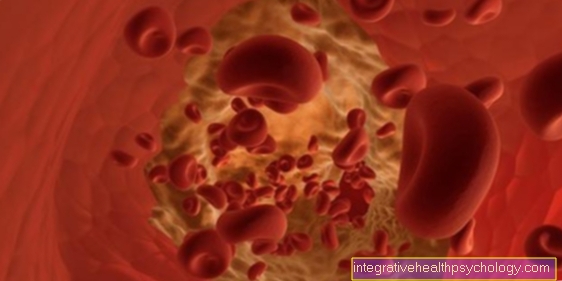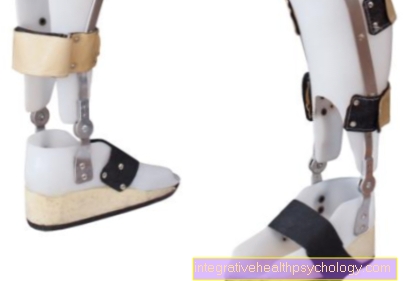Sleeve stomach
definition
A sleeve stomach is the result of a surgical reduction in size of the stomach. During the procedure, the hollow organ is reduced to about a tenth of its original volume. It is an intervention that can be considered in the case of extremely overweight, if all non-operative measures for weight loss have been carried out in vain. Surgical production of a gastric sleeve means that a feeling of satiety occurs after even a small amount of food. This drastically reduces the calorie intake and can usually lose a lot of weight. The gastric sleeve surgery is the most frequently performed operation in Germany for the treatment of extreme obesity by means of stomach reduction.

Indications for gastric sleeve surgery
A gastric sleeve operation is only possible if you are overweight (Obesity per magna) indexed. In order to have a medical justification for the procedure, a few additional conditions must be met. On the one hand, there must be serious side effects associated with being overweight. For example, diabetes mellitus ("Diabetes") or a degenerative joint disease. In addition, all non-surgical measures to reduce body weight should have already been tried in vain. A high level of suffering on the part of the patient and low chances of success for non-operative measures can justify a gastric sleeve operation at an early stage from a medical perspective. An important prerequisite for the indication, however, is always the patient's motivation and cooperation. These aspects must be assessed by the attending physician. If there are any doubts, this can result in a contraindication (contraindication) for the procedure. In order to establish the indication for the procedure, it is also usually a prerequisite that the extreme overweight has existed for at least five years and the patient is not older than 65 years. The general condition must also be good enough so that the operation can be performed without increased risk.
Preparations before the operation
The first step in preparing for gastric sleeve surgery is to check whether the procedure is medically justified. Furthermore, the patient is informed about the procedure, consequences and risks of the operation. The information must be provided in a manner that is understandable for the patient and sufficient time should be allowed for reflection. As before any operation, various examinations are carried out before sleeve gastrointestinal surgery, such as a blood test for the ability to clot and the concentration of the red blood pigment hemoglobin. Further examinations may be required depending on the circumstances of the patient. In some cases, an EKG is done to assess heart function. In addition to examinations, pausing or changing some medications may represent another important step before performing a gastric sleeve surgery.
Procedure of the operation
A gastric sleeve operation is generally performed as part of an inpatient stay under general anesthesia. In most cases, the procedure is minimally invasive using the “keyhole technique” (laparoscopic). The surgical instruments and a camera are introduced into the abdominal cavity through several small incisions in the skin, which is inflated with carbon dioxide gas. As the first step of the operation, the so-called large mesh (greater omentum) is separated from the stomach. In addition, a gastric tube is advanced over the throat and a stapling device is inserted along it. With this, the majority of the stomach is removed and sutured at the same time. The separated part of the stomach is removed from the abdominal cavity through a small incision, which is usually made in the middle abdomen. All that remains is the narrow sleeve stomach, which is located between the esophagus and the duodenum. After completing the actual procedure, the carbon dioxide is released again, the surgical instruments are removed and the abdominal incisions are sutured. The anesthesia is slowly withdrawn until the patient wakes up.
Aftercare
Certain follow-up steps are required after gastric banding surgery. First, examinations are carried out to exclude the possibility that a complication has occurred. In addition, the function of the gastrointestinal tract is checked after the procedure. Another important part of the follow-up treatment is the careful mobilization of the patient as early as possible. The patient should get out of bed for the first time one day after the operation, if possible. On the second day after the operation, a so-called gastrographin swallow is also performed. The patient has to drink a solution with contrast medium and is then x-rayed. This allows possible constrictions or leaks in the gastric tube to be detected. The most time-consuming aspect of the follow-up treatment after creating a gastric sleeve is the gradual increase in diet over weeks and months. There is an increase from initially liquid, easily digestible food to normal food in small portions.
Duration of the operation
The approximate duration of gastric sleeve surgery is around two hours. However, the time required depends on several different aspects and it is only a rough average figure. On the one hand, factors emanating from the patient can influence the duration. For example, an operation in the case of extreme obesity and previous operations in the abdominal cavity is more costly. The duration of the operation also depends on the experience of the surgical team and the center where the operation is performed. If there is a complication such as bleeding from injury to a vessel, the procedure can also take significantly longer than two hours.
Length of hospital stay
The length of hospital stay due to gastric sleeve surgery can vary greatly from person to person, but is usually between a few days and two weeks. Some tests will be done in the days after the operation. In addition, the patient must be mobilized slowly. The length of stay in hospital also depends on how quickly the patient can take care of himself again and how well the wounds heal. In the event of a wound healing disorder or another complication such as a leaky stomach suture, another procedure may be necessary and the length of the hospital stay may be delayed accordingly.
Length of sick leave
How long one is sick or unable to work after a gastric sleeve operation can vary greatly from person to person. After discharge from the hospital, it is usually at the discretion of the family doctor how long he writes the patient unable to work. In addition to the complaints and restrictions, the activity performed must also be taken into account. Work in the office may be more likely to be resumed than heavy physical activity. Even if no general statement can be made, sick leave lasting two to six weeks after gastric sleeve surgery is the most common.
Risks of the operation
When it comes to the risks of gastric sleeve surgery, a distinction can be made between general surgical risks and special risks of this procedure. In general, this and other operations can lead to bleeding with severe blood loss, which can even require the use of blood reserves. It is also possible that the abdominal cavity or wound may become inflamed. Organs and other structures such as nerves can also be injured during the procedure. With every operation, the risk of developing a blockage of the pulmonary circulation due to a blood clot is also increased (pulmonary artery embolism). A special risk of gastric sleeve surgery is that a constriction of the stomach can form, which may have to be enlarged by a second operation. In addition, there may be leaks in the row of seams on the sleeve stomach. This can often only be remedied with another operation.
You might also be interested in: Complications after surgery
Long-term consequences of the surgery
The main long-term consequence of gastric sleeve surgery is that the capacity of the digestive organ is reduced to about a tenth of its original size. As a result, only small portions can be eaten and you will quickly feel full. The long-term desired effect of reducing obesity can be achieved in this way in most cases. However, the feeling of thirst can also be reduced, so that a sufficient supply of fluids must always be ensured after a gastric sleeve operation. Another consequence of the procedure can be insufficient absorption of the vitamin B12, as this can only be absorbed by means of a substance that is produced by the gastric mucosa. In a sleeve stomach, a large part of these cells is no longer present. Therefore, in the long term, a three-month injection of vitamin B12 under the skin is usually necessary. At least the level of the vitamin in the blood should be checked regularly after sleeve stomach surgery, as a deficiency can lead, among other things, to anemia. A deficiency of other vitamins or substances is usually not to be feared in the sleeve stomach compared to some other operations on the stomach, as long as one eats a balanced and healthy diet.
Please also read our article on this Vitamin B12 deficiency.
Can a sleeve stomach be reversed?
In contrast to some other methods of reducing the volume of the stomach, such as the application of a gastric band, a gastric sleeve cannot be reversed. During the procedure, a large part of the digestive organ is removed and is thus irrevocably lost. That is why you should be particularly aware of the lifelong consequences and possible complications before a gastric sleeve operation. Sufficient time for reflection and a clear medical justification for the intervention are therefore essential. If you are uncertain, it can also be useful to obtain an independent second opinion. For patients who reject an irreversible reduction in size of the stomach by creating a tubular stomach, the insertion of a gastric balloon or a gastric band can represent an alternative treatment method for pathological obesity. These two forms of stomach reduction can be reversed with a small operation.
What are the costs of the operation?
The cost of gastric sleeve surgery is in the high four-digit range and can even be more than 10,000 euros. The prices mentioned apply if you have to pay for the operation yourself and have the procedure carried out domestically. If there is a medical indication, however, the health insurance company will usually cover the costs upon request. If you pay yourself, seemingly cheap offers for gastric sleeve surgery often attract people from abroad for less than 5000 euros. However, since this can often be associated with disadvantages and hidden costs, one should be very critical with such offers. If the operation is carried out as a self-payer, the costs can be significantly higher if a complication such as a leak in the stomach suture occurs.
Please also read our article on this The cost of a stomach reduction.
Where and how do I apply for cost coverage?
The application for reimbursement of the costs of gastric sleeve surgery must be submitted to your own statutory or private health insurance company. This must be written individually and in writing. There are various templates and templates on the Internet that can be used as a basis and orientation for your own application. It is advisable to obtain sufficient information in advance as to which aspects must be considered when submitting the application and which requirements must be met so that there is a prospect of the costs of the procedure being covered. The relevant prerequisites may also have to be proven. It can be useful to ask your family doctor early on for assistance in formulating the application. If necessary, you should also find out about the procedure and the conditions in advance from the respective health insurance company.
What are the prerequisites for assumption of costs?
The gastric sleeve surgery is not a standard benefit of the health insurance companies and the assumption of costs must therefore be approved individually on request. Certain requirements apply, all of which must be met for the application to be approved. On the one hand, the body mass index (Abbr .: BMI, body weight in kilograms divided by height in meters squared) are 35kg / m² or higher. In addition, there must be secondary and concomitant diseases of being overweight such as joint diseases or diabetes (“diabetes”). If you have a BMI of over 40, you may not have to prove any accompanying illnesses. In addition, the overweight must have existed for more than three years. The age of the applicant must be between 18 and 65 years, whereby the biological age is usually taken into account. A prerequisite for the assumption of costs is that at least two diet attempts, cures or rehabilitation have been undertaken in vain, if possible under medical guidance. Furthermore, there must be no addictions or other psychiatric illnesses.
What is the difference to gastric bypass?
The gastric bypass is an even more radical form of stomach reduction than the creation of a tubular stomach. A major, more expensive operation is required for gastric bypass. In contrast to the creation of a tubular stomach, with gastric bypass the stomach is not only made smaller, but its lower end is connected to a loop of intestine lying deeper. This excludes the duodenum from digestion. In the sleeve stomach, on the other hand, the natural passage of food from the esophagus via the stomach into the duodenum is preserved. Therefore, especially with gastric bypass, there is a risk of developing a nutrient deficiency. After the procedure, the patient usually has to take certain vitamins, trace elements and proteins in the form of dietary supplements for a lifetime. In addition, the destruction of the natural gastrointestinal passage by gastric bypass can lead to a so-called dumping syndrome. Emptying the stomach contents too quickly into the intestines can lead to nausea, abdominal pain and circulatory problems up to fainting.
You can find detailed information on this topic here: Gastric bypass.
Dumping syndrome
A dumping syndrome can occur if the natural transition from the stomach to the intestines is removed during an operation on the stomach and this leads to the early emptying of stomach contents into the intestine. A distinction is made between early dumping due to an increased influx of fluid from the blood into the intestine attracted by the food pulp and late dumping, which occurs due to an excessive release of the hormone insulin. With a sleeve stomach a dumping syndrome is usually not to be feared. During this procedure, the stomach is significantly reduced in size, but the natural transition to the intestine (gastric gatekeeper) is retained. With other forms of stomach reduction, such as gastric bypass, dumping syndromes are more common.
Read more about this on Diet after a stomach reduction.
Side effect: hair loss
Hair loss is not a typical side effect after gastric sleeve surgery. However, some people experience hair loss after such a procedure. The possible causes are varied and only in some cases can a connection to the intervention be established. On the one hand, a lack of nutrients can cause hair loss. It is therefore particularly important after having a gastric sleeve to ensure a balanced diet and to attend the follow-up examinations. A nutrient deficiency can be detected in the blood if there is suspicion. Hair loss can also be the result of stress. Since gastric sleeve surgery can also be a major psychological burden, it is possible that the symptom may appear during or after the procedure. However, it makes no sense to refrain from gastric sleeve surgery for fear of hair loss. Regardless of the circumstances, if you have excessive hair loss, you should consult a doctor so that the cause can be clarified.
Read more on the topic: Hair loss
Vitamins
Most vitamins can also be fully absorbed in a sleeve stomach, provided you eat a balanced and healthy diet. It is therefore not fundamentally necessary to take vitamin preparations or food supplements. However, vitamin B12 is an exception. This is mainly contained in meat products and can only be absorbed by the body using a substance that is produced by certain cells of the gastric mucosa. In a gastric sleeve operation, a large part of the stomach and thus the cells described is removed. As a result, vitamin B12 can often no longer be absorbed enough, even if it is consumed in sufficient quantities with food. The deficiency can be remedied by injecting the vitamin B12. This has to be done about every three months because the body can store it for that long. A syringe is not always necessary, but you should at least have your family doctor check your vitamin B12 level regularly after a sleeve stomach surgery.
You can find detailed information about this vitamin at Vitamin B12.
Can you still drink alcohol afterwards?
After gastric sleeve surgery, you should not consume alcohol, or only drink small amounts of it. The purpose of the procedure is to reduce the intake of calories by surgically reducing the size of the stomach so that the patient can slowly reduce his or her abnormal excess weight. Alcohol has a high calorie content and alcoholic drinks can also pass the sleeve stomach much more easily than solid food. If you regularly consume alcohol after having a sleeve stomach, you are adding excessive calories to your body so that less or even no fat is broken down. Nevertheless, alcohol can be consumed occasionally and in moderation even after gastric sleeve surgery.
Read more on the topic: Calorific value of alcohol
Further information
You can find more information on the subject of "sleeve stomach" at:
- General information on stomach reduction
- Payment of a stomach reduction
- These are the risks of gastric bypass
- This is what you should keep in mind with obesity
- Post-gastric bypass nutrition







.jpg)







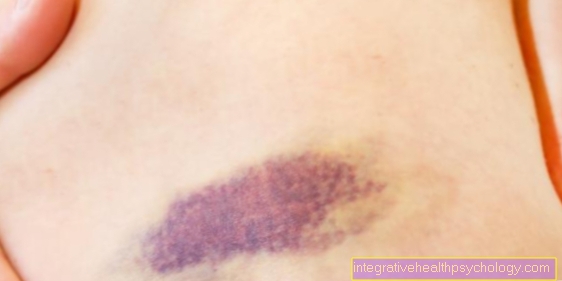
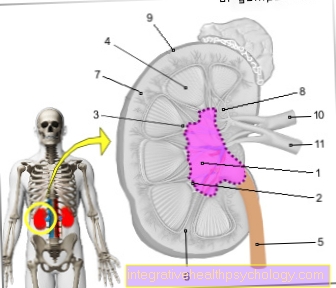
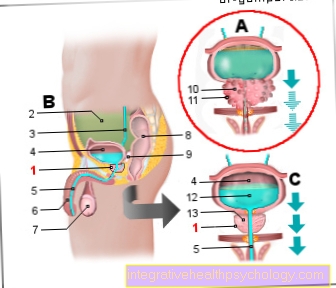



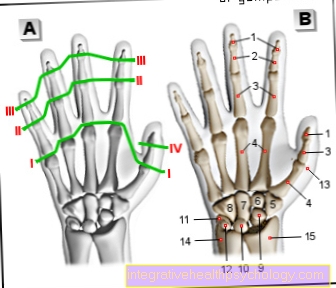
-und-lincosamine.jpg)
